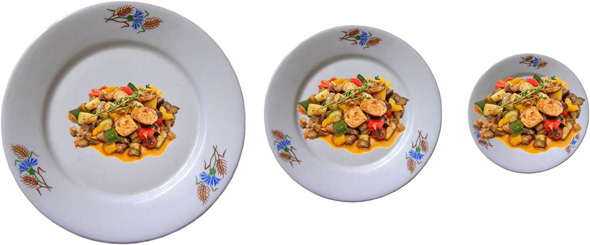
The United States is considered the most obese developed country, yet we have more weight loss diets available than ever in history. Whether you go on a carb counting, ketogenic, paleo or plant-based diet, research shows the size and color of your plate could be the key to finally losing (and keeping off) those unwanted pounds.
Plate Size: Let Your Plate Control Your Portion
The size of the American dinner plate has increased drastically over the decades. In the 1950s, plates were roughly 9 inches in diameter. In the 1980s, they grew to around 10 inches. In 2000, the average dinner plate was 11 inches in diameter, and today, dishes are 12 inches or larger. This isn't taking into consideration restaurant plates, which can sometimes be the size of a small bathtub! In the 1950s, approximately 9 percent of the U.S population was classified as obese. Today, the number of obese people is 40%! Coincidence? Place a small portion of lasagna in the middle of a large plate and it's difficult to resist not piling on more. That’s because the eyes will often influence and guide the stomach. This can make it difficult to use willpower to help reduce the amount of food you consume. The reason is, the quantity of food you eat during a meal is determined to a large extent by the amount of food placed on your plate.
A simple way to cut back on the amount of food you eat is to use a smaller plate. The size of dinnerware influences how much you serve and consume during a meal. Cornell University did a study showing when people switched from 12 inch plates to 10 inch plates, it resulted in 22% less food consumption. This simple trick can help you to lose up weight and keep it off. The reason this works is due to something called the Delboeuf Illusion. This optical illusion occurs when you put a small piece of food on a large plate, your mind will tell you that you are eating a small portion and you will automatically put more food on the plate. However, if you put that same piece of food on a small plate, your mind will tell you that you are eating a large portion and you'll stop adding food. Using smaller plates and bowls can help you to eat less and get full quicker.

The circles of food represented by the dots are the same size on each plate. The Delboeuf illusion makes one dot appear larger than the other. The brain is misled by comparing the dots to the surrounding circles. Forcing yourself to put a small portion of food on a large plate can be tough. From a psychological standpoint, it feels like you are depriving yourself. Meanwhile, the same portion feels bigger and more filling when you see it on a small plate.
In addition to the size, the color of your plate may also be a factor. Research shows that when the color of a person’s plate matches the color of their food, they will tend to eat 30% more. For example, if you ate pasta with red tomato sauce on a dark red plate, you would eat 30% more than you would if you had used a white plate. The same is true if you eat chocolate ice cream in a brown bowl.
People will eat more food when there is less contrast between the color of the food and the color of the plate on which it is served. If you want to cut back on portions, blue plates are the best choice, since blue foods are rare, followed by white.
The shape of your plate can also play a factor. Octagon shaped plates subconsciously make us think of a stop sign which can keep us from eating too much. A thin oval sized plate also lessens how much we eat because the food spreads out farther and gives the illusion there's more on the plate than there actually is. Also, the size of a bowl can have an impact. A tall, narrow bowl may hold the same amount of fluid as a short fat one, but research shows that people feel like they are getting more when they use the tall, narrow version.
The size and color of the cookware you eat on may hold the key to helping you finally lose those stubborn pounds!
References:
https://journals.sagepub.com/doi/10.1068/p5273
https://www.jstor.org/stable/10.1086/662615?seq=1#metadata_info_tab_contents
https://www.theatlantic.com/health/archive/2012/07/the-optical-illusions-of-dinner-plates/259874/
About the Author
Dr. David Friedman is the author of the award-winning, #1 national best-selling book Food Sanity, How to Eat in a World of Fads and Fiction. He's a Doctor of Naturopathy, Chiropractic Neurologist, Clinical Nutritionist, Board Certified Alternative Medical Practitioner, and Board Certified in Integrative Medicine. Dr. Friedman is a syndicated television health expert and host of To Your Good Health Radio, which has changed the face of talk radio by incorporating entertainment, shock value, and solutions to everyday health and wellness issues.
Read more hereFOODSANITY.COM .